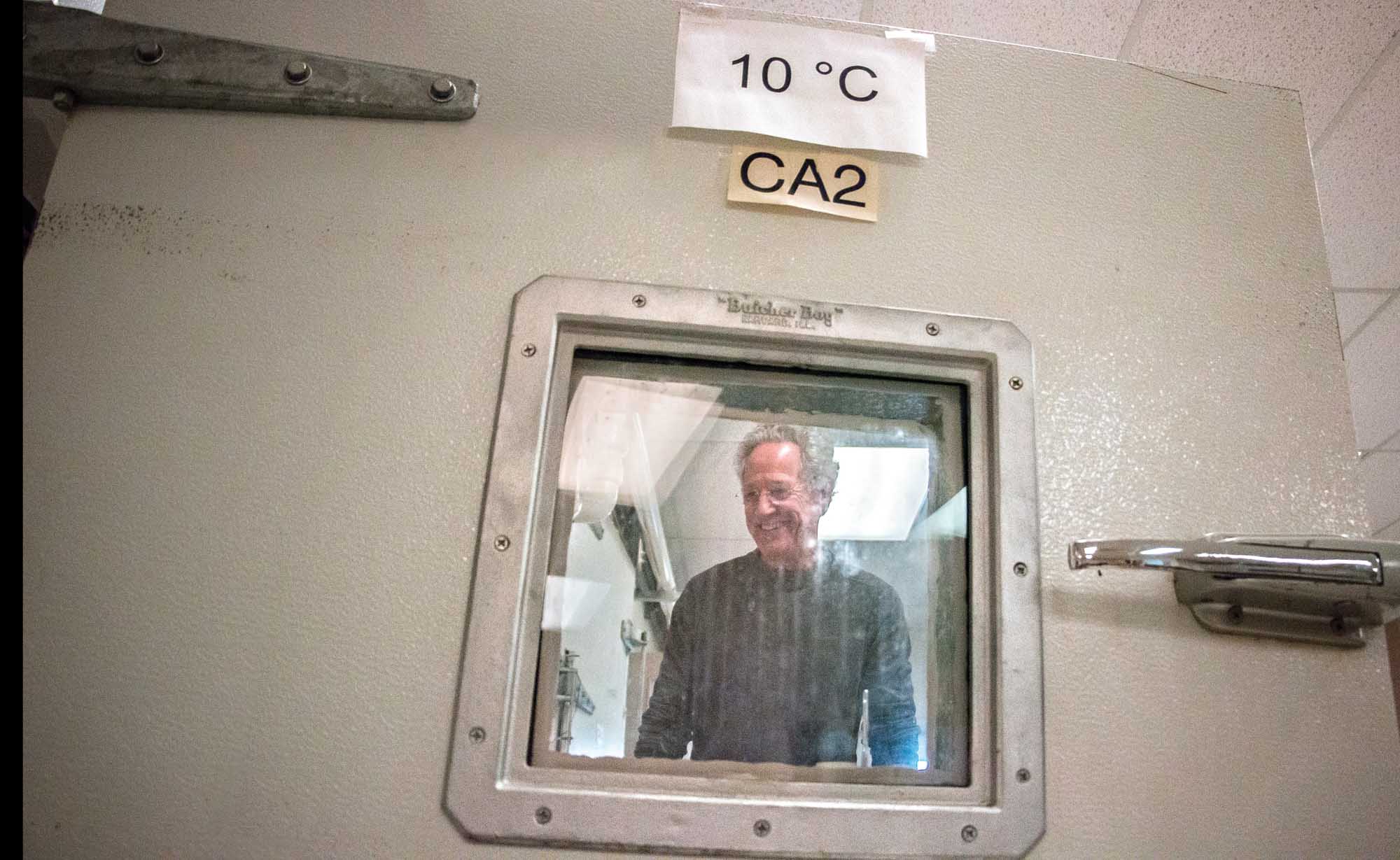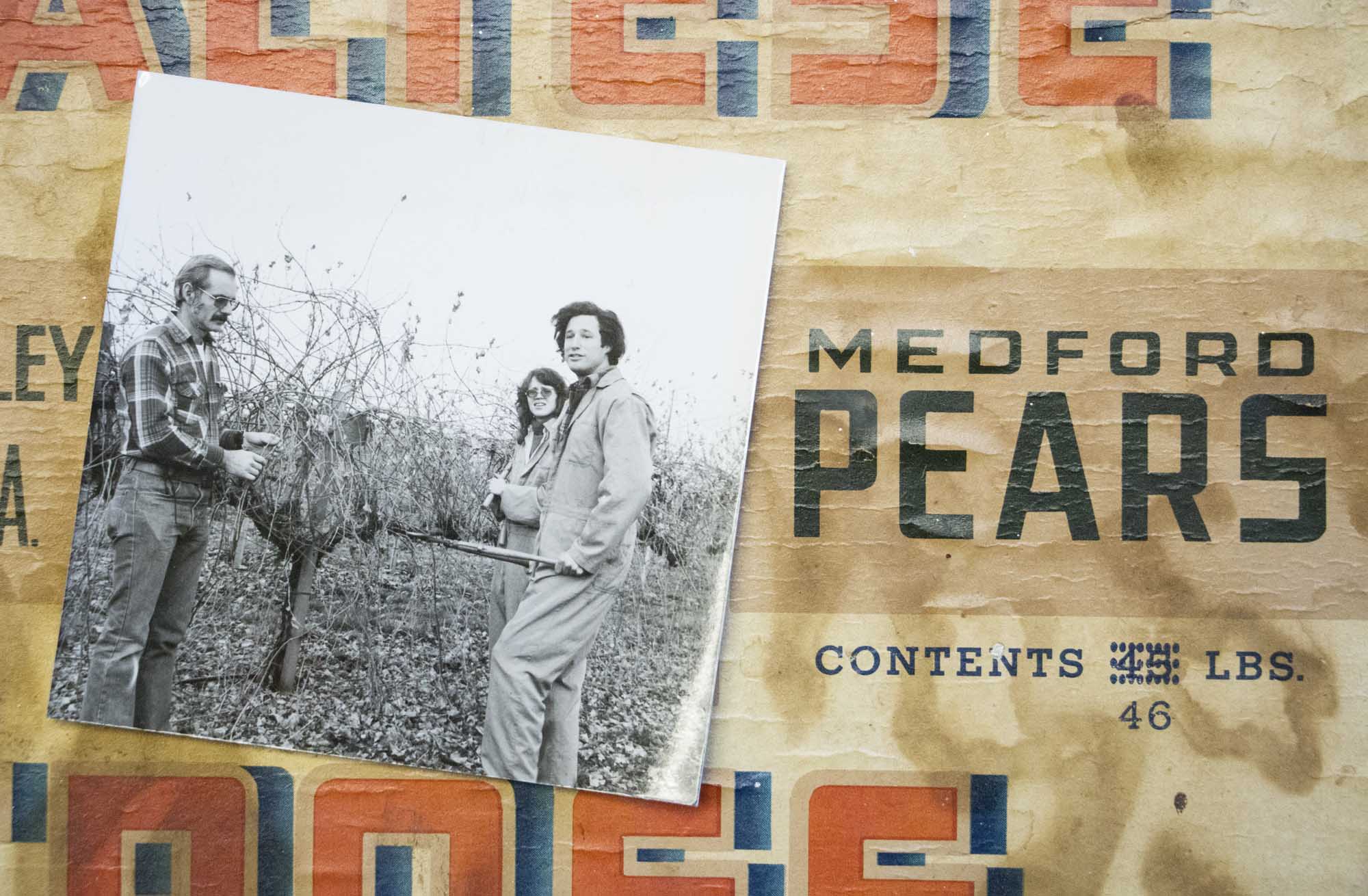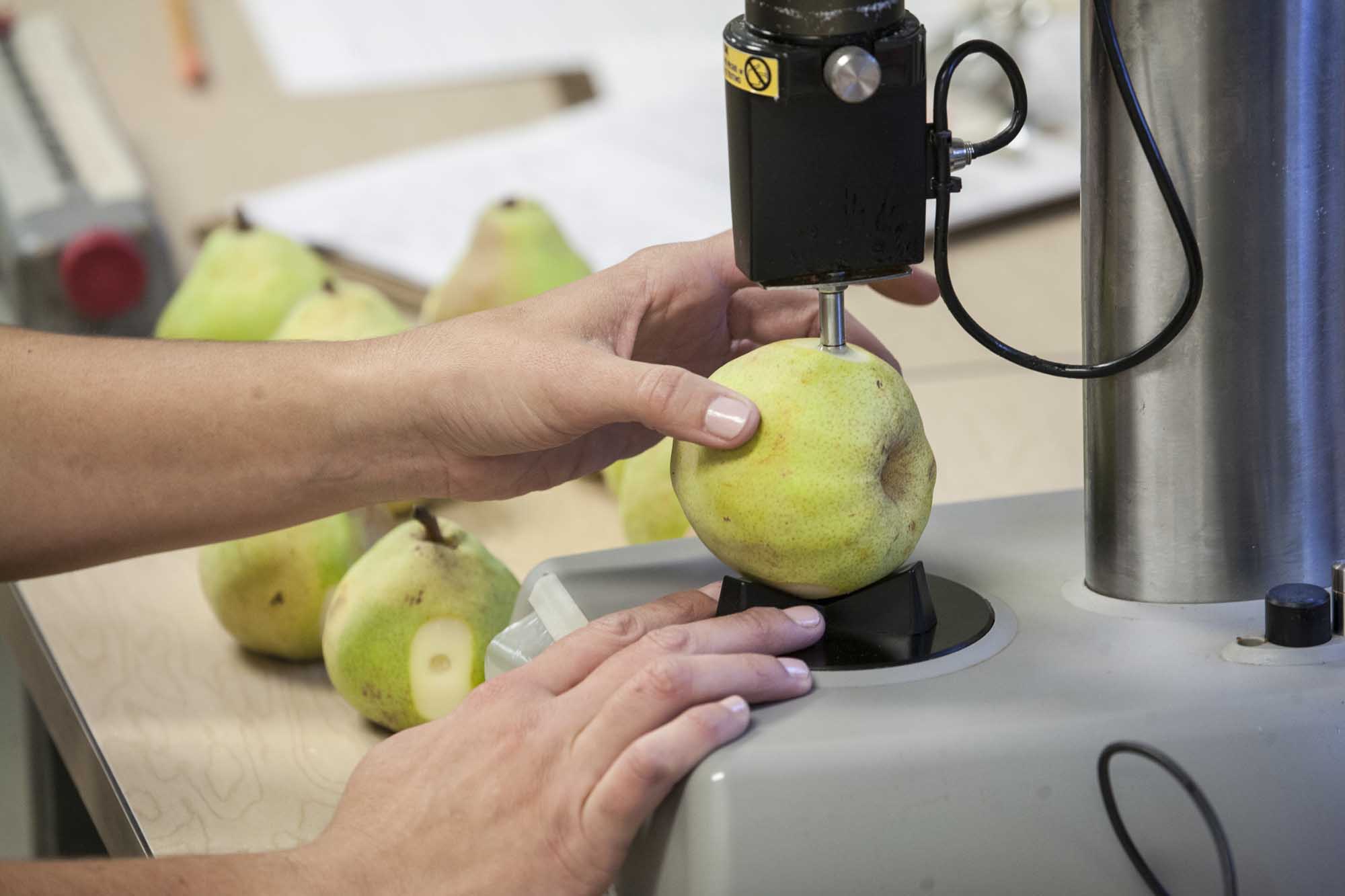
David Sugar is at the center of cold storage testing at Oregon State University’s Southern Oregon Experiment Station in Medford, Oregon. Sugar, is shown through one of three test cold storage rooms at the station in October 2013. (TJ Mullinax/Good Fruit Grower)
Who would have guessed that a city boy from Michigan’s auto town would end up in southern Oregon spending decades to help pear growers and packers better manage postharvest rots and decay? Even Dr. David Sugar, once a Detroit city boy, is surprised at his career path.
Sugar, a plant pathologist at the Southern Oregon University Research and Extension Center in Medford for more than 35 years, retires in May. His research on postharvest fungal decay and diseases of pears has taken him to packing houses, cold storage rooms, and pear orchards in the Pacific Northwest, and to foreign countries like Argentina and Spain to deliver his postharvest gospel.
His current research projects include evaluating thermofogging as a postharvest fungicide treatment on Bosc pears, integrating pre- and postharvest strategies to control decay, evaluating the effect of fireblight materials on pear finish, and pear ripening.
Thermofogging

A young David Sugar, right, learns about grape pruning in 1978 from Oregon State University extension agent Porter Lombard, left. (TJ Mullinax/Good Fruit Grower)
Thermofogging, a method of applying fungicides to cold storage rooms for decay control, is relatively new in the United States, although it’s been in use in Europe for around 20 years.
Globally, more than 1.3 million bins of fruit were treated in 2013, according to Pace International, LLC. In the Pacific Northwest, 700,000 bins in 440 rooms were treated last year. Pace developed the electro-thermofogging system called ecoFOG as a way to protect fruit in storage without drenching.
The technique vaporizes the fungicide into a warm, fine fog to surround the fruit, and their exfiltration technology prevents release of fogging substances into the atmosphere. Thermofogging eliminates the need to dispose of large volumes of fungicides in drench solutions.
Since the first fungicide ecoFOG ETO (ethoxyquin) was registered by Pace for thermofogging in 2005, three others have been approved in the United States: ecoFOG 170 DPA (diphenylamine); ecoFOG 160 PYR (pyrimethanil), also known as Penbotec; and ecoFOG 80 FDL (fludioxonil), also known as Scholar.
“It’s a technique that’s really catchng on within our industry,” said Sugar. “We want to find out if it’s worthwhile for Bosc in our district and if it fits with our pattern of handling pears.” Sugar has studied thermofogging in a commercial pear packing house in Medford for the last two seasons.
In the 2012 season, Sugar worked with Naumes, Inc., to evaluate Penbotec (pyrimethanil) as the thermofogged fungicide. Last year, he studied the application of Scholar. In 2013, fludioxonil was newly registered for thermofogging.
In the first year of the study, Sugar found a 25 percent decrease in infection from gray and blue mold, and a smaller reduction in side rot.
Gray and blue mold cause most of the decay problems in the Northwest, although in Medford, side rot is the bigger problem, he said. Results from the second year are still being analyzed.
Sugar noted that having two fungicides registered for thermofogging gives packers more options for managing fungicide resistance.
Research has shown that using the same fungicide in the packing house for five years in a row creates a risk of resistance.

Pears await further testing as part of a project headed by David Sugar looking at inducing pear ripening. (TJ Mullinax/Good Fruit Grower)
“Bosc are so rot prone that the variety really calls for doing everything you can throw at it,” Sugar said. In the Medford district, thousands of field-run Bosc bins are stored in controlled atmosphere rooms for later packing. Drenching is not done on the truck, and the packing houses do not use a drench during the packing process, he said, leaving fruit vulnerable to decay during storage.
“Research has shown that decay gets very hard to control if it goes unchecked beyond three weeks from infection. By thermofogging the room within a week from harvest—which is a critical moment—we can hopefully provide more protection.”
Sugar is also concluding several years of research to develop decay control strategies for winter pears that integrate pre- and postharvest treatments, using preharvest fungicides and resistance stimulants, such as calcium sprays that work to enhance the fruit’s resistance to decay. Sequential treatment programs, consisting of calcium and ziram in summer, a preharvest fungicide application, a postharvest fungicide or biocontrol, and storage in modified-atmosphere packaging, were the most effective in controlling decay.
Inducing ripening capacity
Another recent project of Sugar’s focuses on conditioning regimes for d’Anjou and Comice pears and looking for ways to accelerate the ripening process with ethylene gas. Pears are typically chilled after harvest or exposed to ethylene gas to induce their own ripening.

Pears that are part of a ripening study headed by David Sugar are being tested for firmness at the Southern Oregon State University research station in Medford. (TJ Mullinax/Good Fruit Grower)
He found that fruit quality (aromatic experience) was greater if ethylene gas was combined with 50°F temperatures during the ripening process. “In the past, packing house operators used one or the other—either ethylene or cold temperatures.
But you need both,” he said, emphasizing that for early picked fruit, the ethylene exposure should be 72 hours and not 24. “It’s a contentious issue because most operators don’t want to seal up a room for 72 hours.”
Other major research accomplishments during Sugar’s three decades of work included identifying pear scab populations resistant to key fungicides and developing control strategies and issuing risk advisories; developing strategies to reduce russet in green-skinned pears and enhance russet in Bosc; and developing ripening techniques for earlier marketing of Comice and d’Anjou pears.
Interest in fungi
So, how did an urban dweller become interested in agriculture?
Although Sugar received a degree in English literature from the University of Michigan in 1971, he had a close friend, also an English literature graduate, who got interested in plants and the environment. The early 1970s were the beginnings of a new environmental awareness.
“My friend (who eventually became head gardener at Thomas Jefferson’s Monticello) was so inspiring that I caught the bug to study plants and the environment and headed West,” said Sugar.
He went to the University of Washington to learn the basics of botany and plant ecology. There, he got interested in plant pathology and agriculture and credits his mycology professor for showing him the world of fungi, agriculture, and research. Because plant pathology and agriculture were not areas of study available at UW, Sugar transferred to the University of California, Davis, for his master’s degree in plant pathology. He received his doctorate in plant pathology from OSU.
He began work at OSU in 1978 as an assistant to Porter Lombard at the research station in Medford. Sugar’s first few years immersed him in the pear industry, and he learned how to prune, irrigate, spray, harvest, and cut out fireblight. “I learned about general pear orchard operations,” he said, noting that he took a brief leave to work on his doctorate in Corvallis, returning to Medford to finish his thesis on postharvest fungal decay of pears.
His understanding of basic horticulture was valuable during his years at the research station because some of the work he did was “purely horticultural.”
For example, he helped develop new OSU pear cultivars (Cascade, BestEver, and Paragon) and evaluated pear rootstocks; quantified color development in red pear varieties and the effects of rootstock, light quality, and evaporative cooling on fruit red color; and developed growth regulator treatments to be used for enhancing fruit size.
“Working with the people in the pear industry and being included in their efforts has been very rewarding, and I feel grateful to have been a part of this industry,” Sugar said. •

David Sugar (TJ Mullinax/Good Fruit Grower)

Leave A Comment